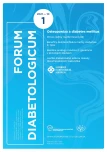Diabetic macular oedema treatment with intravitreal dexamethasone: case report
Authors:
Jana Štefaničková
Authors‘ workplace:
Klinika oftalmológie LF UK a UNB, Nemocnica Ružinov, Bratislava
Published in:
Forum Diab 2021; 10(1): 63-66
Overview
Diabetic macular edema (DME) is a multifactorial disease the pathogenesis of which is affected by a number of angiogenic, vascular and inflammatory processes with the subsequent development of characteristic changes in the macula. Vascular endothelial growth factor (VEGF) blockers – bevacizumab, ranibizumab and aflibercept – are effective in the treatment of DME and they are first-line drugs. However, the mechanism of action of VEGF blockers is focused on only one component of the complex pathology of DEM, and therefore approximately 50% of patients with DEM do not respond adequately to VEGF blockers. For these patients, intravitreal steroids that have different pathomechanisms may be an effective treatment alternative. Administration of steroids may reduce VEGF expression, suppress leukostasis, vascular leakage and reduce pro-inflammatory cytokine production. The evidence of this is the case report of a patient who stopped responding to treatment after several years of treatment with antiVEGF drugs (decrease in central visual acuity after the best correction and increase in swelling shown in OCT), but his anatomical and functional parameters improved after switching to intravitreally administered depot dexamethasone corticosteroid.
Keywords:
aflibercept – bevacizumab– (depot) corticosteroids – dexamethasone – diabetic macular edema – ranibizumab – VEGF-blockers
Sources
- Nguyen QD, Brown DM, Marcus DM et al. RISE and RIDE Research Group. Ranibizumab for diabetic macular edema: results from 2 phase III randomized trials: RISE and RIDE. Ophthalmology 2012; 119(4): 789–801. Dostupné z DOI: <http://doi: 10.1016/j.ophtha.2011.12.039>.
- Wells JA, Glassman AR, Ayala AR et al. [Diabetic Retinopathy Clinical Research Network]. Aflibercept, bevacizumab, or ranibizumab for diabetic macular edema. N Engl J Med 2015; 372(13): 1193–1203. Dostupné z DOI: <http://doi: 10.1056/NEJMoa1414264>.
- Elman MJ, Bressler NM, Qin H et al. [Diabetic Retinopathy Clinical Research Network]. Expanded 2-year follow-up of ranibizumab plus prompt or deferred laser or triamcinolone plus prompt laser for diabetic macular edema. Ophthalmology 2011; 118(4): 609–614. Dostupné z DOI: <http://doi: 10.1016/j.ophtha.2010.12.033>.
- Boyer DS, Yoon YH, Belfort R, Jr. et al. [Ozurdex MEAD Study Group]. Three-year, randomized, sham-controlled trial of dexamethasone intravitreal implant in patients with diabetic macular edema. Ophthalmology 2014; 121(10): 1904–1914. Dostupné z DOI: <http://doi: 10.1016/j.ophtha.2014.04.024>.
- Ozurdex. Skrátená informácia o prípravku. Informácie dostupné z WWW: <https://www.sukl.sk/hlavna-stranka/slovenska-verzia/pomocne-stranky/detail-lieku?page_id=386&lie_id=21707>. 27. 2. 2021.
- Cabrera M, Yeh S, Albini TA. Sustained - release corticosteroid options. J Ophthalmol 2014; 2014 : 164692. Dostupné z DOI: <http://doi: 10.1155/2014/164692>.
Labels
Diabetology Endocrinology Internal medicineArticle was published in
Forum Diabetologicum

Most read in this issue
- Osteoporosis in endocrinopathies
- Second generation basal insulin analogues in clinical trials using continuous monitoring of glucose levels
- De-intensification of treatment in patient with diabetes mellitus could be beneficial
- Population differences in the prevalence of diabetes mellitus, its risk factors and complications
